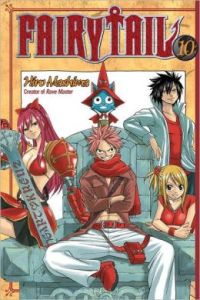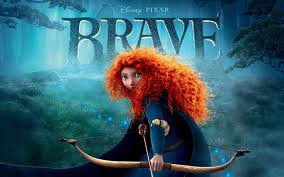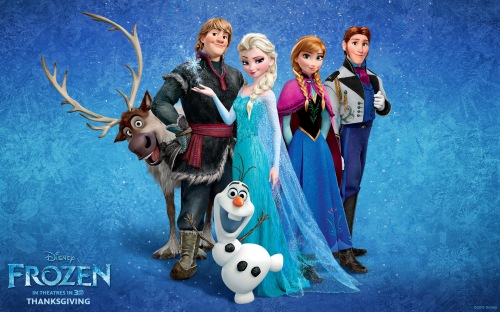From just a glance at the popular shonen series, Fairy Tail, it’s easy to come to the conclusion that this series is one of many that marginalize its female characters to the role of pin-up manga girls rather than, say, useful members of the team. You know, the ones that serve to satisfy the need for disproportionate busts on a slim body, topped with a face featuring big, doe-like eyes who are often featured in boob or panty shots. That was my first impression upon popping open the first volume of the series, which boasts its amply breasted female protagonist, Lucy Heartfilia, on the front. While it can’t be denied that Fairy Tail‘s female characters do suffer from something I like to call “power boobs,” the series boasts an array of female characters who actually are powerful, as opposed to the many faux action girls we see in shonen and other fiction. So, what are we supposed to make of this long-running action/adventure series?
Fairy Tail centers around a group of young wizards in a fantastical world of dragons and flying cats where people can join specialty guilds, including powerful guilds for wizards who take on job requests ranging from mundane to highly dangerous for money. Right away, Fairy Tail caught my interest by choosing to start the story following Lucy, a female wizard looking for one of the most well known (and slightly infamous) guilds around, Fairy Tail. Opening with a female character is a move that seems to be fairly rare in a sea of shonen series with male protagonists. Natsu, the boy Lucy meets while looking for Fairy Tail, is arguably the real protagonist of the series, evident from the fact that he is the one to fight the main villains and is often featured front and center on the cover, but the narrative usually sweeps back to her at the start of a new arc. As the rest of the guild is introduced, the series continues to impress when Erza, an armor-wearing, sword-wielding woman who takes command even in the presence of her male teammates and is one of the strongest members of the guild, enters the picture. And unlike some series, where only one or two female characters make frequent appearances, it quickly becomes clear that Fairy Tail is a world realistically populated with both sexes.
Unfortunately, what also becomes clear is that out of the wide cast of female characters, ranging from villains to heroes, a couple have moderate to small chest sizes (one of those characters being a little girl) while the rest are drawn with very prominent breasts(1). Of course, it’s not just that practically all of the girls have large bust lines, but also the way the series cashes in on fanservice. Lucy is often featured in super-tight tank tops showing cleavage and even a little side boob, and even Erza uses magical armor that transforms into different sets, ranging from beautiful but impractical armor showing breast and skin to outfits that were clearly made as an excuse to show Titania wearing cat ears or in a sexy goth lolita look. Many of the other powerful female guild members are also highly sexualized in battle and out such as Mira, the wickedly strong demon girl turned wizard pin-up girl, which links back to the old power boobs trend. (Lucy aspires to be a featured pin-up girl in one of the wizard magazines like Mira one day, something she makes clear from the start of the series.) Frankly, whether the character wears more conservative outfits or not, the chest always seems to be accentuated. The female members of the guild also participate in beauty contests wearing swimsuits and cheer leading outfits, just to make sure your attention is where is should be. Despite the great power and skill of the women in the series, Fairy Tail falls into the trap of putting focus on the female characters’ bodies rather than their abilities.
The emphasis on the girls’ sexuality(2) continues in reoccurring jokes throughout the series, jokes that are usually at the cost of Lucy’s dignity. In volume 17, she’s humiliated twice, once when her short skirt falls down, revealing what readers can assume is her underwear since we see her skirt around her ankles and a few male characters gawking with hearts bulging out of their eyes, and a second time when an enemy transforms herself into Lucy and lifts her top to show off Lucy’s breasts. An ongoing joke is the perverted master of the guild, an old man with an adult grandson,who constantly hits on the girls in the guild. One of the most blatant and disturbing examples of this behavior comes when the guild master uses punishment as a thinly veiled excuse to repeatedly slap Lucy’s backside. It’s all supposed to be funny, but I find it especially troubling when a girl’s humiliation or sexual harassment are made into a sexually gratifying joke for readers. Fortunately, the latter type of fan service is not as prominent in the series as the former type, but the problems still remain. No matter which kind of fanservice it is, the overwhelming amount of it in manga (and in other forms of fiction) perpetuate ideas that men should look at women as breasts and butts or objects of sexual fantasy, a problem we certainly have here in the United States.
Of course, not everything is about how the female characters look. This cast of female characters has had plenty of chances to fight on their own and to prove that they are, in fact, capable members of the team. In almost every arc that I’ve read so far (up to volume 18), the girls typically play a larger or less gendered role in fights than some of the heroines in other shonen series. Too often, female characters in other series get sidelined as healers or stuck fighting–and even losing to–nameless villains while their male counterparts defeat the top guys, if they do anything at all. In Fairy Tail, the girls tend to get their chance to show off their worth. Erza takes out, or at least weakened, some of the major enemies and even Lucy usually defeats a notable villain or two. Many of the female characters who aren’t lead ladies are pretty powerful in their own right as well.
Still, there are some problems on the battlefield, too. Despite Lucy’s power, she’s still one of the weakest, and often says so herself. In addition, some of her biggest battles in the series recently have featured her summoning a Celestial Spirit (magical beings she makes contracts with and who usually fight in her stead) who looks just like a young man. Yes, I know, Lucy has the power to summon strong beings, which isn’t something to sneeze at, but when she summons something that looks like he could be any other powerful guy, it seems like she’s calling for a knight to save her from danger rather than a magical being summoned by her own strength.
Another issues arises when comparing how the series puts its male characters in a pinch versus its female characters. Male characters such as Gray struggle with similar emotional and physical duress that their female counterparts do, in which they face despair and take extreme action that requires their teammates to go after them and talk some sense into them, only the female characters are kidnapped so far. Their capture forces the other members to go save them, putting the girls in temporary states of near-to-complete helplessness. The example that perhaps best sums up this phenomenon is during an arc involving the entire guild, when all of the main female members are held hostage in a plot to get the guild members to battle each other. The rest of the guild fight against their wishes to ensure that the girls aren’t harmed. To add insult to injury, the battle is designed to determine who is the strongest in the guild, yet the girls are completely discounted from the start (3).
Nevertheless, the girls don’t usually stay completely helpless for long. In the above scenario, the hostages aren’t rescued by one of the many guys fighting to save them, but rather Erza. In general, Erza is viewed as a huge threat by her enemies and gets some great heroic moments that rival those of any male teammate of the series’ protagonist. Similarly, despite the fact that it’s a minor mission, Lucy shows herself capable enough to go off by herself and take out a whole gang of criminals. In addition, as a commenter on one of my previous posts points out, there have been some women in influential positions such as those on the Magic Council, a group of powerful wizards with a lot of authority over the guilds and wizards of the world.
So, eighteen volumes in and Fairy Tail is a mixed bag for me as far as its female characters are concerned. It’s a fun, whimsical series, but it hasn’t risen above some classic shonen series, forcing readers to suffer a whole cast of big breasted, fanservice females who all seem to get their chance to be damsels in distress. It does, however, offer fans a number of female characters who are regularly shown to be capable in their own right. I’ll keep reading, and I’m planning on writing more about what the series does right in an upcoming post, but in the meantime, what are your thoughts on the female characters of Fairy Tail?
- I know that in the past, some readers have argued that attacking the sexy way in which female manga/anime characters dress reminds them of slut slamming or that it seems like I am making fun of women with large breasts so, I will state my distinction now: if a creator of a fictional female character decides to present her in a hyper sexual fashion, complete with over-emphasized breasts, I must address how that person has chosen to depict women. Rather than thinking of these characters as women choosing to present themselves a certain way, compare it to how media such as Playboy make conscious choices in the clothing, positioning, and, in all likelihood, photoshopping of female models to make them appealing to male consumers. If a real woman has large breasts or makes the decision to dress in a revealing manner, that is a different matter.
- To be fair, Mashima, the creator of Fairy Tail, does include fan service for his female readers as well. Most evident is one of the lead male characters, Gray, who has a habit of stripping off his shirt or even down to his underwear at random yet frequent moments of the series. I appreciate that Mashima tries to even things out, and making men the object of fan service seems to be some people’s response to “equality,” but I’m not convinced that giving men the same treatment that women get is the right answer.
- It should be noted that Natsu is initially excluded as well, but he is not being held hostage.

























